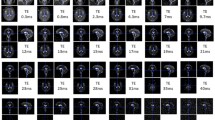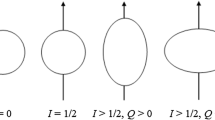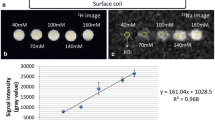Abstract
Object
Sodium MRI is typically concerned with measuring tissue sodium concentration. This requires the minimization of relaxation weighting. However, 23Na relaxation may itself be interesting to explore, given an underlying mechanism (i.e. the electric-quadrupole-moment–electric-field-gradient interaction) that differs from 1H. A new sodium sequence was developed to enhance 23Na relaxation contrast without decreasing signal-to-noise ratio.
Materials and Methods
The new sequence, labeled Projection Acquisition in the steady-state with Coherent MAgNetization (PACMAN), uses gradient refocusing of transverse magnetization following readout, a short repetition time, and a long radiofrequency excitation pulse. It was developed using simulation, verified in model environments (saline and agar), and evaluated in the brain of three healthy adult volunteers.
Results
Projection Acquisition in the steady-state with Coherent MAgNetization generates a large positive contrast-to-noise ratio (CNR) between saline and agar, matching simulation-based design. In addition to enhanced CNR between cerebral spinal fluid and brain tissue in vivo, PACMAN develops substantial contrast between gray and white matter. Further simulation shows that PACMAN has a ln(T 2f/T 1) contrast dependence (where T 2f is the fast component of 23Na T 2), as well as residual quadrupole interaction dependence.
Conclusion
The relaxation dependence of PACMAN sodium MRI may provide contrast related to macromolecular tissue structure.










Similar content being viewed by others
References
Inglese M, Madelin G, Oesingmann N, Babb JS, Wu W, Stoeckel B, Herbert J, Johnson G (2010) Brain tissue sodium concentration in multiple sclerosis: a sodium imaging study at 3 Tesla. Brain 133:847–857
Nielles-Vallespin S, Weber MA, Bock M, Bongers A, Speier P, Combs SE, Wohrle J, Lehmann-Horn F, Essig M, Schad LR (2007) 3D radial projection technique with ultrashort echo times for sodium MRI: clinical applications in human brain and skeletal muscle. Magn Reson Med 57(1):74–81
Boada FE, Christensen JD, Huanghellinger FR, Reese TG, Thulborn KR (1994) Quantitative in vivo tissue sodium concentration maps—the effects of biexponential relaxation. Magn Reson Med 32(2):219–223
Thulborn KR, Gindin TS, Davis D, Erb P (1999) Comprehensive MR imaging protocol for stroke management: tissue sodium concentration as a measure of tissue viability in nonhuman primate studies and in clinical studies. Radiology 213(1):156–166
Ouwerkerk R, Bleich KB, Gillen JS, Pomper MG, Bottomley PA (2003) Tissue sodium concentration in human brain tumors as measured with Na-23 mr imaging. Radiology 227(2):529–537
Ouwerkerk R, Bottomley PA, Solaiyappan M, Spooner AE, Tomaselli GF, Wu KC, Weiss RG (2008) Tissue sodium concentration in myocardial infarction in humans: a quantitative Na-23 MR imaging study. Radiology 248(1):88–96
Ouwerkerk R, Jacobs MA, Macura KJ, Wolff AC, Stearns V, Mezban SD, Khouri NF, Bluemke DA, Bottomley PA (2007) Elevated tissue sodium concentration in malignant breast lesions detected with non-invasive Na-23 MRI. Breast Cancer Res Treat 106(2):151–160
Woessner DE (2001) NMR relaxation of spin-(3)/(2) nuclei: effects of structure, order, and dynamics in aqueous heterogeneous systems. Concept Magn Reson 13(5):294–325
Rooney WD, Springer CS (1991) A comprehensive approach to the analysis and interpretation of the resonances of spins 3/2 from living systems. NMR Biomed 4(5):209–226
Hubbard PS (1970) Nonexponential nuclear magnetic relaxation by quadrupole interactions. J Chem Phys 53(3):985
Nagel AM, Bock M, Hartmann C, Gerigk L, Neumann JO, Weber MA, Bendszus M, Radbruch A, Wick W, Schlemmer HP, Semmler W, Biller A (2011) The potential of relaxation-weighted sodium magnetic resonance imaging as demonstrated on brain tumors. Invest Radiol 46(9):539–547
Winkler SS, Thomasson DM, Sherwood K, Perman WH (1989) Regional T2 and sodium concentration estimates in the normal human-brain by Na-23 mr imaging at 1.5 T. J Comput Assist Tomogr 13(4):561–566
Bartha R, Menon RS (2004) Long component time constant of Na-23 T*(2) relaxation in healthy human brain. Magn Reson Med 52(2):407–410
Fleysher L, Oesingmann N, Stoeckel B, Grossman RI, Inglese M (2009) Sodium long-component T-2* mapping in human brain at 7 Tesla. Magn Reson Med 62(5):1338–1341
Winter PM, Bansal N (2001) Triple-quantum-filtered Na-23 NMR spectroscopy of subcutaneously implanted 9 l gliosarcoma in the rat in the presence of tmdotp5-. J Magn Reson 152(1):70–78
Rooney WD, Springer CS (1991) The molecular environment of intracellular sodium—Na-23 NMR relaxation. NMR Biomed 4(5):227–245
Halle B, Wennerstrom H, Piculell L (1984) Interpretation of counterion spin relaxation in poly-electrolyte solutions. J Phys Chem 88(12):2482–2494
Springer CS (1996) Biological systems: spin 3/2 nuclei. Encycl Nucl Magn Reson. doi:10.1002/9780470034590
Stobbe R, Beaulieu C (2008) Sodium imaging optimization under specific absorption rate constraint. Magn Reson Med 59(2):345–355
Hussain MS, Stobbe RW, Bhagat YA, Emery D, Butcher KS, Manawadu D, Rizvi N, Maheshwari P, Scozzafava J, Shuaib A, Beaulieu C (2009) Sodium imaging intensity increases with time after human ischemic stroke. Ann Neurol 66(1):55–62
Hancu I, van der Maarel JRC, Boada FE (2000) A model for the dynamics of spins 3/2 in biological media: signal loss during radiofrequency excitation in triple-quantum-filtered sodium MRI. J Magn Reson 147(2):179–191
Joseph PM, Summers RM (1987) The flip-angle effect—a method for detection of Na-23 quadrupole splitting in tissue. Magn Reson Med 4(1):67–77
Watts A, Stobbe RW, Beaulieu C (2011) Signal-to-noise optimization for sodium MRI of the human knee at 4.7 Tesla using steady state. Magn Reson Med 66(3):697–705
Stobbe R, Beaulieu C (2005) In vivo sodium magnetic resonance imaging of the human brain using soft inversion recovery fluid attenuation. Magn Reson Med 54(5):1305–1310
Tsang A, Stobbe RW, Beaulieu C (2013) Evaluation of b-inhomogeneity correction for triple-quantum-filtered sodium MRI of the human brain at 4.7T. J Magn Reson 230C:134–144
Tsang A, Stobbe RW, Beaulieu C (2012) Triple-quantum-filtered sodium imaging of the human brain at 4.7T. Magn Reson Med 67(6):1633–1643
Stobbe R, Beaulieu C (2006) Sodium relaxometry: towards the characterization of the sodium NMR environment in the human brain using a novel relaxometry technique. Proceedings of the 14th Annual Meeting of ISMRM, Seattle, Washington, USA, p 3104
Boada FE, Gillen JS, Shen GX, Chang SY, Thulborn KR (1997) Fast three dimensional sodium imaging. Magn Reson Med 37(5):706–715
Stobbe R, Beaulieu C (2008) Advantage of sampling density weighted apodization over postacquisition filtering apodization for sodium MRI of the human brain. Magn Reson Med 60(4):981–986
Kharrazian R, Jakob PM (2006) Dynamics of Na-23 during completely balanced steady-state free precession. J Magn Reson 179(1):73–84
Pandey L, Towta S, Hughes DG (1986) NMR pulse response and measurement of the quadrupole coupling-constant of 1 = 3/2 nuclei. J Chem Phys 85(12):6923–6927
Stobbe R, Beaulieu C (2009) Sodium ‘invisibility’ in signal quantum sodium imaging of the human brain at high field. Proceedings of the 16th Annual Meeting of ISMRM, Honolulu, Hawaii, USA
Reddy R, Bolinger L, Shinnar M, Noyszewski E, Leigh JS (1995) Detection of residual quadrupolar interaction in human skeletal-muscle and brain in vivo via multiple-quantum filtered sodium NMR-spectra. Magn Reson Med 33(1):134–139
Laustsen C, Ringgaard S, Pedersen M, Nielsen NC (2010) Quadrupolar-coupling-specific binomial pulse sequences for in vivo Na-23 NMR and MRI. J Magn Reson 206(1):139–146
Woessner DE, Bansal N (1998) Temporal characteristics of NMR signals from spin 3/2 nuclei of incompletely disordered systems. J Magn Reson 133(1):21–35
Van der Maarel JRC (2003) Thermal relaxation and coherence dynamics of spin 3/2. I. Static and fluctuating quadrupolar interactions in the multipole basis. Concept Magn Reson A 19A(2):97–116
Sigma-Aldrich Gelatin product information. http://www.sigmaaldrich.com/etc/medialib/docs/Sigma/Product_Information_Sheet/g1393pis.Par.0001.File.tmp/g1393pis.pdf
Mitsuiki M, Mizuno A, Motoki M (1999) Determination of molecular weight of agars and effect of the molecular weight on the glass transition. J Agric Food Chem 47(2):473–478
ICF Consulting, United States Department of Agriculture (USDA) (2006) Gellan gum handling/processing
Winter PM, Bansal N (2001) Tmdotp5- as a Na-23 shift reagent for the subcutaneously implanted 9 l gliosarcoma in rats. Magn Reson Med 45(3):436–442
Zaaraoui W, Konstandin S, Audoin B, Nagel AM, Rico A, Malikova I, Soulier E, Viout P, Confort-Gouny S, Cozzone PJ, Pelletier J, Schad LR, Ranjeva JP (2012) Distribution of brain sodium accumulation correlates with disability in multiple sclerosis: a cross-sectional Na-23 mr imaging study. Radiology 264(3):859–867
Acknowledgments
The authors thank Alberta Innovates Health Solutions (CB-Salary) and the Natural Science and Engineering Research Council of Canada (Operating).
Author information
Authors and Affiliations
Corresponding author
Rights and permissions
About this article
Cite this article
Stobbe, R.W., Beaulieu, C. Exploring and enhancing relaxation-based sodium MRI contrast. Magn Reson Mater Phy 27, 21–33 (2014). https://doi.org/10.1007/s10334-013-0390-7
Received:
Revised:
Accepted:
Published:
Issue Date:
DOI: https://doi.org/10.1007/s10334-013-0390-7




